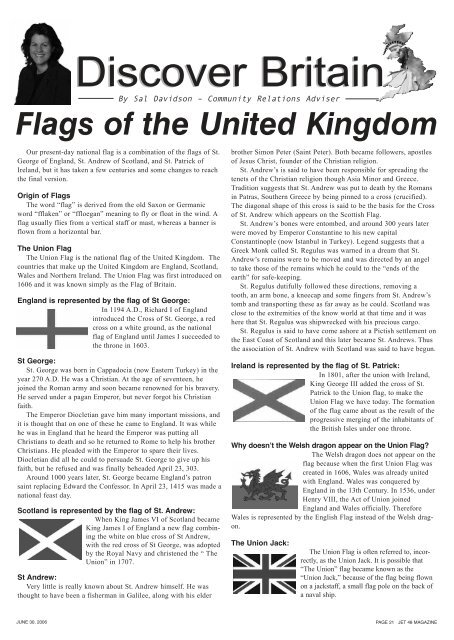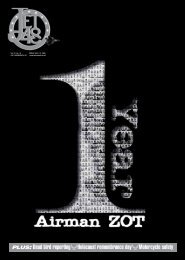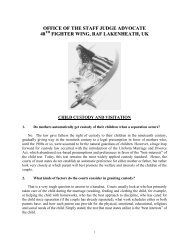By Sal Davidson – Community Relations AdviserFlags of the United KingdomOur present-day national flag is a combination of the flags of St.George of England, St. Andrew of Scotland, and St. Patrick ofIreland, but it has taken a few centuries and some changes to reachthe final version.Origin of FlagsThe word “flag” is derived from the old Saxon or Germanicword “fflaken” or “ffloegan” meaning to fly or float in the wind. Aflag usually flies from a vertical staff or mast, whereas a banner isflown from a horizontal bar.The Union FlagThe Union Flag is the national flag of the United Kingdom. Thecountries that make up the United Kingdom are England, Scotland,Wales and Northern Ireland. The Union Flag was first introduced on1606 and it was known simply as the Flag of Britain.England is represented by the flag of St George:In 1194 A.D., Richard I of Englandintroduced the Cross of St. George, a redcross on a white ground, as the nationalflag of England until James I succeeded tothe throne in 1603.St George:St. George was born in Cappadocia (now Eastern Turkey) in theyear 270 A.D. He was a Christian. At the age of seventeen, hejoined the Roman army and soon became renowned for his bravery.He served under a pagan Emperor, but never forgot his Christianfaith.The Emperor Diocletian gave him many important missions, andit is thought that on one of these he came to England. It was whilehe was in England that he heard the Emperor was putting allChristians to death and so he returned to Rome to help his brotherChristians. He pleaded with the Emperor to spare their lives.Diocletian did all he could to persuade St. George to give up hisfaith, but he refused and was finally beheaded April 23, 303.Around 1000 years later, St. George became England’s patronsaint replacing Edward the Confessor. In April 23, 1415 was made anational feast day.Scotland is represented by the flag of St. Andrew:When King James VI of Scotland becameKing James I of England a new flag combiningthe white on blue cross of St Andrew,with the red cross of St George, was adoptedby the Royal Navy and christened the “ TheUnion” in 1707.St Andrew:Very little is really known about St. Andrew himself. He wasthought to have been a fisherman in Galilee, along with his elderbrother Simon Peter (Saint Peter). Both became followers, apostlesof Jesus Christ, founder of the Christian religion.St. Andrew’s is said to have been responsible for spreading thetenets of the Christian religion though Asia Minor and Greece.Tradition suggests that St. Andrew was put to death by the Romansin Patras, Southern Greece by being pinned to a cross (crucified).The diagonal shape of this cross is said to be the basis for the Crossof St. Andrew which appears on the Scottish Flag.St. Andrew’s bones were entombed, and around 300 years laterwere moved by Emperor Constantine to his new capitalConstantinople (now Istanbul in Turkey). Legend suggests that aGreek Monk called St. Regulus was warned in a dream that St.Andrew’s remains were to be moved and was directed by an angelto take those of the remains which he could to the “ends of theearth” for safe-keeping.St. Regulus dutifully followed these directions, removing atooth, an arm bone, a kneecap and some fingers from St. Andrew’stomb and transporting these as far away as he could. Scotland wasclose to the extremities of the know world at that time and it washere that St. Regulus was shipwrecked with his precious cargo.St. Regulus is said to have come ashore at a Pictish settlement onthe East Coast of Scotland and this later became St. Andrews. Thusthe association of St. Andrew with Scotland was said to have begun.Ireland is represented by the flag of St. Patrick:In 1801, after the union with Ireland,King George III added the cross of St.Patrick to the Union flag, to make theUnion Flag we have today. The formationof the flag came about as the result of theprogressive merging of the inhabitants ofthe British Isles under one throne.Why doesn’t the Welsh dragon appear on the Union Flag?The Welsh dragon does not appear on theflag because when the first Union Flag wascreated in 1606, Wales was already unitedwith England. Wales was conquered byEngland in the 13th Century. In 1536, underHenry VIII, the Act of Union joinedEngland and Wales officially. ThereforeWales is represented by the English Flag instead of the Welsh dragon.The Union Jack:The Union Flag is often referred to, incorrectly,as the Union Jack. It is possible that“The Union” flag became known as the“Union Jack,” because of the flag being flownon a jackstaff, a small flag pole on the back ofa naval ship.JUNE 30, 2006PAGE 21 JET 48 MAGAZINE
Jet48CommunityMovies<strong>RAF</strong> <strong>Lakenheath</strong> 226-2139Today6:30 p.m. The Wild, G, starring Kiefer Sutherland andEddie Izzard. In this computer-animated comedy-adventure,an assortment of animals from the New York Zoo -including a lion, a giraffe, an anaconda, a koala, and asquirrel - discover what a jungle the city can be when oneof their own is mistakenly shipped to the wild and theyembark on a dangerous mission to rescue him.9 p.m. The Wild, G.Saturday12 p.m. The Wild, G.2 p.m. The Fast and The Furious: Tokyo Drift, PG-13,starring Lucas Black and Shad ‘Bow Wow’ Gregory Moss.Sean Boswell is an outsider who attempts to define himselfas a hot-headed, underdogstreet racer. Although racingprovides a temporaryescape from an unhappyhome and the superficialworld around him, it hasalso made Sean unpopularwith the local authorities.To avoid jail time, Sean issent to live with his gruff,estranged father, a careermilitary-man stationed inTokyo.4:30 p.m. Scary Movie 4,PG-13, starring MollyShannon and Anna Faris.The Scary Movie gang isback with send-ups of “WarCourtesy graphicof the Worlds,” “TheGrudge,” “The Village,” “Saw” and “Saw II,” “Million DollarBaby” and much more. Legendary comedy director DavidZucker (“Airplane!,” the “Naked Gun” franchise, “ScaryMovie 3,” and “Ruthless People”) and producer Bob Weissreunite to take aim at some of the best fright films, the latestbox office hits, music, current events, pop culture, andyour favorite celebrities.Sunday2 p.m. The Wild, G.Monday6:30 p.m. Scary Movie 4, PG-13.Tuesday6:30 p.m. The Fast and The Furious: Tokyo Drift, PG-13.Wednesday6:30 p.m. The Fast and The Furious: Tokyo Drift, PG-13.Thursday6:30 p.m. The Fast and The Furious: Tokyo Drift, PG-13.<strong>RAF</strong> Mildenhall 238-4955Today6:30 p.m. The Wild, G.9 p.m. Scary Movie 4, PG-13.Saturday3:30 p.m. The Wild, G.6:30 p.m. Scary Movie4, PG-13.9 p.m. Cars, G, starringOwen Wilson and PaulNewman. LightningMcQueen, a hotshotrookie race car driven tosucceed, discovers thatlife is about the journey,not the finish line, whenhe finds himself unexpectedlydetoured in thesleepy Route 66 town ofRadiator Springs. Onroute across the countryto the big Piston CupChampionship inCalifornia to competeCourtesy graphicagainst two seasoned pros, McQueen gets to know thetown’s offbeat characters—including Sally, a snazzy 2002Porsche, Doc Hudson, a 1951 Hudson Hornet with a mysteriouspast, and Mater, a rusty but trusty tow truck voiced,who help him realize that there are more important thingsthan trophies, fame and sponsorship.Sunday3:30 p.m. The Wild, G.6:30 p.m. Scary Movie 4, PG-13.Monday6:30 p.m. The Wild, G.Tuesday6:30 p.m. Cars, G.Wednesday6:30 p.m. Scary Movie 4, PG-13.Thursday6:30 p.m. Cars, G.BULLETINBOARDBriefsJob fairThe <strong>Lakenheath</strong> commissary is having ajob fair 9 a.m. to 2 p.m., Saturday. The commissaryhas openings as cashiers, deli/bakeryfood service workers and store workers.Those interested in positions should call(01638) 52 3515 and ask for Sarah.Furnishings management officeBecause of traffic restrictions on <strong>RAF</strong>Feltwell during the Independence Day celebrationthe furnishings management office willclose at 12 p.m., Monday. The FMO will openat 10 a.m., Tuesday. For questions, call 226-7154/7334.MOD Independence Day policySupervisors may use a liberal leave policyespecially if work requirements arereduced significantly on the holiday.Employees are required to work, or theymay request leave. Activities should scheduleworkloads to ensure effective utilizationof MOD employees on those days.Employees will be excused from duty, withpay, only when circumstances prevent managementfrom assigning duties. (ForIndustrial MOD Employees: compensatorydays earned according to the Industrialworking time administration arrangement istaken on U.S. holidays. Employees who donot have compensatory time to their creditwill be required to work or may requestleave.)Tim WestwoodTim Westwood from the popular BBCshow “Pimp My Ride, U.K.” will be at the48th Avenue from noon until 6 p.m., Saturday.For more information, call 266-4884.Independence day celebration, busscheduleThe bus for the Independence Day celebrationon July 3 will depart <strong>RAF</strong><strong>Lakenheath</strong> hospital every 30 minutes startingat 9:30 a.m. The bus at <strong>RAF</strong> Feltwell willdepart every 30 minutes starting at 9:55 a.m.The last bus will depart <strong>RAF</strong> Feltwell at12:25 a.m.An Independence Day celebration will beheld at <strong>RAF</strong> Feltwell from 10 a.m. until midnightMonday. The base will be open to thepublic from noon until midnight.American LegionServicemembers interested in joining anAmerican Legion in the local area contact,London Post No. 1. Form more informationcall (01353) 722 775 or e-mailrafikicd.wheeling@virgin.net.Change of command ceremoniesThe 48th Aircraft Maintenance Squadronwill have a change of command ceremony at9 a.m., Wednesday at Hangar 6.The 48th Service Squadron will have achange of command ceremony at 10 a.m.,July 7 at the Eagle’s Landing.Water report availableA short new report is available that willtell you what’s in your tap water.Visit it at: https://48medweb.lakenheath.af.mil/amds-sgpb/Environmental.htmor call the 48th Medical <strong>Group</strong>’sBioenvironmental Engineering at (01638) 528047 to receive the report.Instructors neededCentral Texas College – <strong>Lakenheath</strong> isnow accepting applications for classroominstructors in the following fields: criminaljustice, early childhood professions, emergencymedical technology, food servicesmanagement, paralegal studies, fire sciences,automotive technician, applied managementand military science. For those with educationand experience in one of these fields,stop by the CTC office in the education centeror contact the CTC representative at 226-3507 or lakenheath@europe.ctcd.edu.The American Red CrossThe <strong>RAF</strong> <strong>Lakenheath</strong> American RedCross Summer Youth Volunteer programruns July 10 through Aug. 11 for ages 12 to21. Orientations are scheduled for 9 a.m.,June 26, 30 and July 7 in Building 950. Preregistrationis required for the orientation.For more information, call the Red Crossoffice at 226-1855.PAGE 22 JET 48 MAGAZINE JUNE 30, 2006
















